| Hardware World |
WITH AN estimated 1.5 million Spectrums still in rubber keyboards, and more being produced for the overseas market, add-on keyboards are still selling well. The latest to be released is the Lazer 62 from Micro Board.
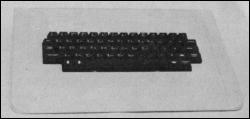
The 62 stands for the number of keys, the original 40 plus an extra 22 single key functions. Other extras are proper moving keys, not a membrane as on the Spectrum Plus, a full-sized space bar and a built in on/off switch.
Those extras are not without cost, £59.95 to be precise, and one or two corners have been cut in the manufacture. Despite that, if you are careful when assembling it, it has a lot to offer in this already crowded market.
Assembly entails removing the circuit board from the Spectrum and then clipping it into the base. The top of the keyboard is made of plastic, with a suitable area to rest your hands when typing, but the base is metal and that presents the first problem.
As the keyboard is very thin, standing just over 4cm high, there is very little clearance between the PCB and the base. Although there is one strip of plastic tape as an insulator that only covers a small area and it is not totally adequate. For piece of mind on the review model I added many yards of sticky tape.
The keyboard proper is clipped above the PCB, again a tight fit, and the top of the case over that. That is problem number two. On the review model the casing fouled the keys so that some of them would not spring back after they had been pressed. A few minutes with a sharp knife cured this.
Once the keyboard is screwed together you then have to stick the legends on the keys, with 62 keys a long job. Later models should have a better fitting case and re-designed legends, the current ones being printed all in white.
Where the keyboard scores is the multitude of extra keys. Those are £ # ( ) " - + ; : = , . / * plus four shifted cursor keys, E mode, delete, Edit and Caps Lock. Unlike many keyboards with single key functions it will still work with programs that use Interrupt Mode 2 - such as Beta Basic.
With the availability of the Spectrum Plus upgrade - see elsewhere in Hardware World - at £20.00 the Lazer 62 represents a hefty investment, but if you want proper keys it has much to offer. The keys have a reasonable feel and a spot of grease works wonders.
Further details from Micro Board International, Surrey.
Twillstar MC3810 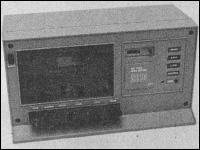
|
Binatone Data Recorder 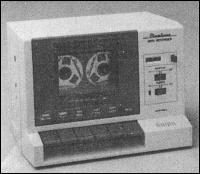
|
JUDGING from our mail bag many users experience difficulty finding a suitable cassette deck to use with their computer. Ever ready to bow to your wishes we obtained two computer-dedicated decks for review.
The first, the Twillstar MC3810, priced £25.95 made us realise the sort of problems you are liable to encounter. The instructions are completely in German.
Special cassette leads are supplied for the Spectrum which terminate, at the deck end, in a six-pin and seven-pin DIN plug. Why so many pins are required when only two are used is still a mystery.
The drive mechanism is held vertically and features full autostop and an air-damped door. It has a counter and there are five lights on the front which show if you are loading or saving, and if a signal is present.
The deck saved and loaded with no problems - you do not have to swop leads - and managed to load our specially-prepared poor quality tape.
Hoping to fare better we looked at the second deck, the Binatone Data Recorder, priced £29.95. This is more compact than the Twillstar unit and has the power supply inside - you have to add your own mains plug. It uses the Sinclair supplied cassette leads and the instructions, in English, even have a diagram of a Spectrum showing what to plug in where.
The deck mechanism is again held vertically and the door damped. To the right is a counter, on/off switch and monitor switch. On the side is a volume control, although it features an ALC - Automatic Level Control - and a phase switch which inverts the signal. The whole thing is securely held in a beige plastic case.
We saved a program and then tried to load it back. This proved to be impossible. The tape would load on another cassette recorder and we could hear the signal using the monitor, but it just would not load.
Details from Twillstar Computers Ltd, Middlesex, and Binatone International Ltd, Middlesex.
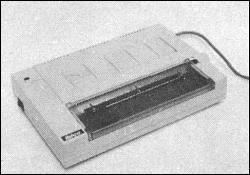
WHILE the prices of dot matrix printers have been falling in recent years the price of daisywheel printers has remained fairly high, with only one at under £300. The Ibico LTR-1 is an 'impact band' printer which gives daisywheel quality print for only £169.95.
The low price means that it has a limited number of features, but surprisingly it has both Centronics and RS232C inputs as standard.
The printer is small, measuring 298mm by 63mm by 198mm, and is designed to take standard A4 sheets of paper. Tractor-fed paper can be used if the perforations are removed. There are no feed buttons provided, only a manual knob which, annoyingly, has to be pushed in and turned to feed the paper. You can only feed forwards.
Few control codes are available. The printer uses a buffer to store one line before it is printed. Carriage return and line feed operate as normal except that if they are received in reverse order double space printing is performed. Backspace deletes the previous character in the buffer, which means that you cannot use underscore to underline text.
Like a daisywheel the printer is fairly slow. It operates at 12 characters per second, which is average for a daisywheel.
Despite those limitations we had no problems driving it from both Tasword II and Quill or obtaining listings. The output is reminiscent to that from a portable typewriter and, apart from being uneven in places, was very good. If you are looking for a low cost daisywheel printer the LTR-1 represents value for money.
For further details contact Saga Systems, Surrey.
KEMPSTON compatible joystick interfaces are popular at the moment and the latest to be released is the Bud Pilot, priced £9.95. The only difference between it and all others is the inclusion of a power-on LED and the fact that it uses a 23-way (ZX-81 style) edge connector. That enables it to fit behind other add-ons, such as the ZX Printer and Interface Two.
For more information of this and other interfaces contact Bud Computers Ltd, Northumberland.
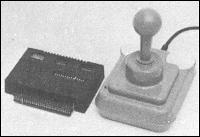
Pro Interface, Formula 1 |
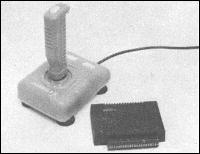
Standard interface, Formula 2 |
KEMPSTON has greeted the launch of the Spectrum Plus by redesigning all its hardware to be easily fitted to the new machine.
Kempston, of course, are noted for inventing the Kempston standard for joystick interfaces and the price is now down to £9.95. The instructions supplied with it contain a useful routine to convert Psion's Flight Simulator to the Kempston standard. The Pro joystick interface, which has three sockets - Kempston and Cursor on one and Sinclair on the other two - plus a ROM socket, is now £19.95.
The company has also brought out two new joysticks, the Formula 1 and 2. The Formula 2 is the cheaper at £11.95 and features three fire buttons, one on the stick and two on the base. It is similar to the Quickshot I, and has a similar sloppy feel, even down to the rubber suckers on the bottom.
The Formula 1, at £16.95, is a much more rugged joystick. It uses microswitches for the stick and leaf switches for the two large fire buttons. Kempston says that all internal parts can be replaced.
Another new addition is the Score Board joystick, priced £28.95. That is simply a joystick with a very large base, similar in size to a rubber Spectrum, with two fire buttons.
Further information from Kempston Micro Electronics Ltd, Bedfordshire.
IN ORDER to answer some of its critics Sinclair has released the Spectrum Upgrade Kit, which will turn your rubber keyed Spectrum into a Spectrum Plus. What is more, the kit only costs £20.00 and will not invalidate your warranty when fitted. If you do not want to fit it yourself Sinclair offers an upgrade service, for £30.00.
The upgrade kit is largely the same as any other add-on keyboard but may require some soldering. As a bonus, however, you get a new Spectrum Plus manual and cassette. The manual merely demonstrates how good the old manual was.
Fitting is straightforward and helped considerably by the clear instruction sheet. A new heat sink is provided for Issues 1 and 2, which is slightly smaller than the original, to fit the new case.
Next is the reset switch, soldered into place. It can, if you are not used to soldering, be left out.
Now you can test the new keyboard. Not all Spectrums will work correctly at this point. The company tends to use the cheapest components which means that each Spectrum will vary slightly. To overcome that a resistor - provided - has to be soldered onto the circuit board, a very fiddly operation.
You now have a Spectrum Plus. If you cannot get it to work Sinclair offers a fixing service, for £10.00. Send them the bits and they return a working computer.
As an add-on keyboard it offers 58 keys - 12 of them single key functions - and a half-sized space bar. Most useful are the shifted cursor keys and the only surprise is the omission of a colon key.
The keyboard feels cramped in use and is actually 0.5cm smaller across the Q and P keys than the rubber Spectrum. The caps are printed all in white which makes finding shifted functions difficult.
At £20.00 it is a bargain and, unless you are prepared to spend more than twice that, very good.
Write to Sinclair Research Ltd, Surrey.